>hidweh???
in so many words the biokinesis egregore
about page: https://docs.google.com/document/d/e/2PACX-1vQQ7-445TrIYxYztD_nFb8VmDBGiW-IK0bF22DTO585NMu68UW75V7EdXZ79OVLE8uQBWoQrUoWZ_D_/pub
hidweh rituals 1.02:
https://drive.google.com/file/d/1e7oYlrg1ne_eBME3fYbi-SfvFRqq_pZp/view?usp=sharing
second mass: https://archive.4plebs.org/x/thread/39974941/#39974941
first mass organization thread: https://archive.4plebs.org/x/thread/39916823/
stream:
https://psp-tv.com/r/hidweh

star
md5: 94748ae7babfe87b0eab137c98ab3090
🔍
>prayer
Oneiropompus of guts,
How we crave your melatonin voice!
May the body’s lullaby reach us
And may it reach your ears as well
Let our bones hear our nerves
And our nerves hear our soul
The melody of flesh and mind
Locked together and intertwined
something that has been really bothering me concerns what would be the appropriate religious form for a religious movement on an imageboard. this is not a problem that has been thought much about for obvious reasons but it is one that ought to be contended with. on /inana/ there was a discussion of how exactly their stuff with ishtar could kick off https://archive.4plebs.org/x/thread/40073170/#40092256. there’s been a bit of a lament of how the whole ishtar thing seems destined to remain a fringe socio-political movement completely localized to /x/. in general i feel there is a certain directionlessness in ishtar worship. there are a few rituals one can do and some people do seem to be working with her but there feels like lack a certain level of vitality. i guess one thing that i see isn’t present is hat element of communion or group interaction. its rather disconnected practice, with occasional questions here and there as well as arguments with christians or whatever. perhaps we may not expect too much from an imagebaord after all… is this however true?

>>40755947we need to first think about what are the fundamental preconditions for communion in the first place. the first point is enaction. there needs to be some real involvement on the part of the participants in order to make them a part of something larger. a sharp difference between irl and online activity is that in the the former, you are capable of performing repetitive actions and it still constitutes some degree of exertion. in the latter, you are able to just copy and paste mantras, images etc, so that part of the sacred character is lost. perhaps the best way to retain some level of energy expenditure is via continual improvisation. by the production of new works, the artist must reinvent themselves. we also need to think about here how this enaction may made a community event. the first part of this can be gathered by looking at already existing practices of imageboard culture.
one such practice would be drawfags wherein people request certain images to be drawn for them concerning a particular person. such a tradition could easily be adapted to divine figures, and seems like a natural step for this type of website. so much of the attention economy of imageboards is dictated by the quality and capturing facility of an image. of course this alone is not enough. these images must be made sacred in some way or related to religious adherence.
in general a pattern ive been seeing is this tendency to rely on scholarly and primary sources when dealing with various pagan deities. partly behind this is a particular concern for authenticity. id say that it is this latent fear of trampling on something authentic that has been a reason why i have not touched ishtar worship as i have hidweh. for hidweh since there is no pre-existing tradition, i feel more emboldened to develop and experiment with my own practices. with this said however, i think there is an element of this that must be moved past.

>>40755948obviously we no longer live is ancient mesopotamia to begin with and are very much removed from a lot of the practices that involved these deities. there is just so much material lost to the sands of time that it is difficult fashioning something actually coherent from all of this.
there is also the fact that there were particular social conditions that existed back when ishtar was worshipped which are no longer present now. there is no physical temple or physical gathering place for instance. we are all just shitposting on chatrooms and korean basketweaving forums. something else i am going by is also the article here:
https://acoup.blog/2019/11/01/collections-practical-polytheism-part-ii-practice/
a key concept they espouse is how much of the worship of the gods is grounded in a sort of pragmatism. offerings and rituals were done in order for rain or good harvest to come for instance. the development of ritual follows from what things appeared to have worked. it is this pragmatic backbone that a more serious spiritual practice can be gradually developed. it is not necessarily something that just gets developed overnight.
moving back to the subject of a sacred form of drawfagging there are a few influences i would like to bring into this. the first would be icons from orthodox and catholic christianity. what’s interesting about these is that they are not mere depictions but are also meant to be interfaces in which the divine is able to be revealed to us and we may have some sort of relation. icons have this tendency to provoke an austere reverence and deepened faith. honestly on /inana/, through the posting of ishtar-rin and other such depictions, there is already a movement hear towards icon-focused worship. this article further elaborates on this notion
http://opentranscripts.org/transcript/selfhood-and-the-icon/

>>40755951>Iconographic paintings are not signifiers but are physical structures that exist in both worlds. A picture of a saint is not a picture of a saint, it is the saint, physically in space with you.>I’d like to touch base on some more recent history. Walter Benjamin’s iconic 1935 essay on the mechanized field of aesthetics. Benjamin claims that in the past, the role of artistic production has been to provide a magical foundation for the cult. He claims that then, value was located in a central position within ritual and religious tradition, a statue or an idol has a detached authority and power which is implicit only as rooted in time.here there we see the problem of repeatability brought up here again:
>The mass reproduction of such an object was not just unlikely, it was unimaginable. To remove it from its history was to render it useless to itself, to remove the aura of object, that detached and transcendental beauty.>But a digital object appears across a multiplicity of screens both at once and forever. These entities are not individually manipulable, which is to say they do not exist in multiples that can accumulate their singular times and histories and auras, but as a single form. In this space, a copy is not a manipulation, it’s a recreationwhat the author here happens to be stressing is the aspect of participation that can still be relevant to the audience. the nature of the digital transforms our consumption of images to be much more like having a relation to some platonic entity (and hence moving closer to relation with the divine) than an individual object. in a drawfag like thread there is an opportunity for both active and passive participation with transpersonal beings to join together in this way.
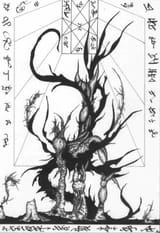
>>40755957of course i think we could also develop further techniques on the part of passive participation by taking notes on theophanic traditions which make use of hypnagogia. the azoetia seems to also involve a sacred relation with sorcerous artwork. i think it is still important that one bothers to actually form a deepened relationship with the images formed, rather than have it something be mass-created by some ai or something, otherwise something of the sacredness gets destroyed. pure repetition of sameness preserves the ideality of the original, while artistic possession re-enfleshes the gods in a vital manner. meanwhile purely artificial means of producing works try and manufacture novelty as though “the new” is just a fetish and not of the gods’ influence.
speaking of the azoetia, chumbley has developed a few rituals in the past for making use of possession for automatic drawing. for instance in the opuscula magica he instructs one to hold the hand in a fixed posture until the hand also loses its feeling. afterwards one releases the hand from its posture (while keeping the mind clear of thoughts/latching onto the feeling of the hand’s vanishing?) until feeling returns to hand. after this one can recite an invocation before letting the drawing begin. you can find the invocation written on page 25 of this pdf document:
https://ia801607.us.archive.org/13/items/opuscula-magica-volume-1-andrew-d-chumbley/Opuscula_Magica_Volume_1_Andrew_D_Chumbley.pdf
this takes us to our second influence here would be traditional witchcraft. as i said already, chumbley plays a lot with divine icons and their use as a means of gaining gnosis. schulke also dedicates some works to this topic. in particular idolatry restor’d provides a great historical overview of these practices. i especially find this quote animating:
I don't know what these threads mean and I don't think anyone except OP knows what they mean either. Schizo word salad.

>>40755961>Despite ancient religious bans upon idols and their worship, the Holy Images of the gods persisted in the inheritors of Rome, itself a great reservoir of effigy and idol magic. The 'triumph' of Christianity over older religious imagery was dealt a blow in the early Renaissance by the rediscovery of ancient pagan iconography in subterranean grottoes, and its gradual incorporation in the design elements of gardens , architecture, visual and literary art.17 Whilst the Gods of Old Rome and Greece were not officially revived in religious cults, the surface images of European culture suggested precisely the opposite, intimating an ingression of ancient power, via aesthesis, into the art and magical philosophy of the present. Embodied in these images were attributes of divinity absent in Christianity, particularly nudity, romantic sexuality, license, fertility, and the virtues of wildness. Thus was the outpouring of sexualized 'pagan' imagery permitted in the context of ornamentation and philosophical contemplation, even whilst Protestant iconoclasm raged during the Reformationi think this quote speaks to the sort of deity ishtar even is. a theme ive seen recur on /inana/ is that of embracing desire and in some of ishtar’s hymns u see a motion towards the embrace of sexuality. behind these icons is the transmission of a greater pagan ethos
this takes me also to how all of this can be related to what ishtar is as a being. i keep fixating on the fact that she is both a goddess of love and war, because it is a very productive contradiction. we may also think of her as a goddess of beauty and strife. while beauty has of course an immediate connection to art, we can also see that Beauty is the Good qua manifestation.
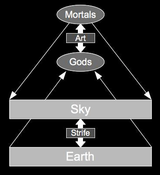
>>40755971insofar as icons relate to the manifestation of divine, we also see a connection here. this theme is perhaps multiplied in the title of her as “queen of heaven” and some lingering associations of her with the mother mary. the heaven or the sky resonates with the concept of akasha or aether which is meant to be the basic medium underneath all manifestation. it also makes me think of heidegger’s discussion of his fourfold as well
https://that-which.com/heidegger-the-fourfold/
>The sky is the place of the shining of things and stars. The sky is that into which the earth extends itself and marks its limits, yet the sky is also that from which the earth withdraws and, by withdrawing, lets the things shine and radiate through the sky. The sky is not simply an emptiness or a void, but rather the space in which changing, moving, becoming-different, and difference occur. The sky is the place in which that which appears arises and converses with us, with the mortals. The sky covers, and is above, the earth and the mortals. This covering changes the things and weathers them, for the thing is linked together with, and refers to, what lies beyond it, the sky.notice here that there is not only a discussion here of manifestation but also of becoming-different. this relates to the question of iterability once again. the imageboard format and the general nature of digital technology demands that we write and rewrite, draw and redraw, if we are to actually participate in these practices as active participants and not just passive recievers. it is also somewhat resonant with derrida’s discussion of writing as always already involving a rewriting. in some sense we have never really had a religion that fully makes use of the sort of opportunities derrida thinks writing provides.
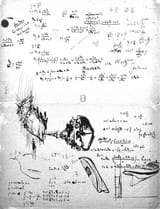
>>40755979of course the bible is one the best instances we have though. it spawns numerous different interpretations from its many apparent inconsistencies. to me this is not a failure of a bible but a design feature that ensures the book has a shelf-life that lasts a long time. how all of this relates to the topic of the death of the author is also very interesting as well…
https://www.scirp.org/journal/paperinformation?paperid=112551
>To write is to produce a mark that will constitute a kind of machine that is in turn productive, that my future disappearance in principle will not prevent from functioning and from yielding, and yielding itself to, reading and rewriting… For the written to be the written, it must continue to “act” and to be legible even if what is called the author of the writing no longer answers for what he has written, for what he seems to have signed, whether he is provisionally absent, or if he is dead…this withdrawal of the author is something i think we see radicalized within the context of imageboards wherein people is typically anonymous, hence all of their individual voices recede. and combining with the point on icons being an interface, what comes into the foreground becomes a particular latent ideality. perhaps even dumb threads like the nobody general are a manifestation of this tendency par excellence. the imageboard format from such a perspective encourages an even deeper manifestation of the gods than we have hitherto seen, provided we let particular limiters be untwisted and particular techniques to synchronize with the deity are kept

>>40755987the relation to mother mary i think is also very interesting. in my head ive been somehow thinking of a sort of “christian polytheism”. to me what is interesting about polytheism is that it embraces the fact that there are multiple different modes of being, and it supports a relation to the divine that is not ontotheological. at the same time there is also the question that someone like peterson would pose of how ought these different polytheistic faiths interact with eachother. you can always think of a bit of a highest level. from this i was thinking about maybe yahweh somehow fitting into it though there is a lot of jewish jingoistic baggage. there is also the fact that we can understand trinitarian doctrine as christ’s flesh as revelation of the being of the logos, hence jesus’s divinity is related to ontological theophany rather than metaphysics. if this was the case, what of the theotokos? she birthed the revelatory flesh, hence establishing her as a being that is intimately related to the bringing about of manifestation. insofar as she is the bringing about, an aspect of her is thus beyond manifestation hence cthonic. this leads to her representation as hekate. oh yeah there is an astrological bit in all of this also how jesus was associated in some passages of the bible w the morning star and ishtar of course being the morning star too..

>>40755992and then there is also the part of her which related to war. as i said before divine icons are a way in which pagan and polyvocal values may enter further into our consciousness. they constitute a bit of an assault on consensus reality. this also makes me think about jorjani’s elaboration on the concept of weltanschauungskrieg (rough translation: “worldview warfare”). this is where certain people become aware of their facticity (understanding of themselves as constrained within a particular context/perspective they are thrown into) to the point where they can make use of sort of knowledge to think about manipulating the world-view of other cultures. this practice i think is something that is not at all alien to imageboards either. i feel as though imageboard users tend to be generally more cognizant of “board culture” and also the norms and customs of other online spaces. in contrast, most people tend to have this persistent idea in the back of the head that their sensibilities are just the objective way the world works and everyone should conform to it, even people of a different internet culture than them. there is also of anonymous trolling/raiding operations and psyops that have been done in the past (though of course less now). this form of conflict is if anything just our natural language
>>40756000with all of this musing, what do i suggest from here? i think more people should pick up arts and crafts and get to learning stuff. /inana/ (and hidweh threads too) can be used as places where not only rituals are discussed but also the production of art (it should be noted that astaroth is related to the crafts so..) there needs to be an initiative to the production of original artwork and people taking requests. these artworks can be used for divine contemplation or for rituals. id also suggest more people check out schulke’s ‘idolatry restor’d’ and ‘lux haeresis’. also check out the azoetia. also godform assumption rituals might be one way to get into deeper resonance for schizo prophet induction https://hermetic.com/stavish/rituals/godform. maybe as an alternative one can perform durga mantra too
>>40755963https://www.youtube.com/watch?v=ptfZ3IPkAOY
i just realized i accidentally called this hidweh mass 10 when it should be 11... sigh im just gunna leave it like that

Frame15
md5: 6dda4c4dcaf69eb1668ba8434398025d
🔍
>>40756011omg that's right i got distracted talking to family and i almost forgot. spare also expands on themes of iterability and innovation. he abhors convention and stresses the importance of the artist to constantly channel new forms
from zos speaks:
>TO BECOME oblique is one answer: but our minds have heaped up cliches, coined, borrowed or inherited, mostly spurious. So stultified - not by limits of language, or by dumbness - we fail through falsities and half-believing, by fears bred of cramped growth, obedience to uninspired patterning, and we lose our impassioned creativeness by accepting easy conventions, idioms, and shoddy imitations.>WHILE learning, always do what you would avoid doing; difficulties will not cease but fear of them will and this is the beginning of great facilities. Those who give up adopt the ease of convention and others' idioms of arrestment.spare also is sympathetic to the idea of religion being tied to art
also from the tradition of german idealism there is a tendency to place religion within the same area as art within their overall system as a form of picture-thinking attempt at representing the absolute. christ is often a representation of the how man is not only a subject but also an outgrowth of spiritual substance/collective consciousness. there we see a further elaboration on the theme of manifestation. it also makes me think of the idea of Gesamtkunstwerk (total work of art) which i think is a sort of ideal that any religious tradition should strive to achieve

>prayer
Janus-faced goddess of flesh,
You show love is God, as is war
In the body fire, through it unity
Contradiction in matter, paradox in soul
Each strand of time in tension with the other
Every chronal bead for our greedy bowl
May the past lick us sharper
As you lick deeper our selves of milk
last time i had talked about the sokai gakai and how there is an overall ethics of excess underlying everything we are doing. i would say so far ethically, we’ve had people largely thinking in terms of life-affirmation or life-denying. these are both ultimately grounded on a zero-sum picture of the cosmos which discounts the individual’s ability to produce surplus product. what i am thinking of may be termed instead “life-creating”. i want to divorce myself further from the cannibalistic logic that has infected all of our thinking of a better tomorrow. from such a perspective i would also move further against nietzsche’s thinking as it overemphasizes power accumulation to be gained from dominating others, and underplays the potency of power accumulation turned inwards as a means of producing a sort of perpetual energy machine. i also think that from the standpoint of ethical excess, compassion becomes something that is much more natural. this does not come from a place of pity or even morality per se, but a natural energetic outpouring that ignites others.
the truly powerful man helps others because he stands above the present archonic world-system of equivalent exchange. that is one of our ultimate goal, to transcend fate and acquire a deeper draconic state of corporeal mutability. it is the strength to rise above the darwinian paradigm of natural selection and rise towards a higher paradigm wherein evolution is done orthogenically while still tied to ones ethical horizon. this tie is not one of obligation, but a self-imposed possession towards ever-evolving visions within the context of a local socius.

ldo
md5: bd428cdaef1c929fce7b599211977180
🔍
>>40756972there is also an element here of stewarding collective virtue as well. contra tendencies seen in o9a, the focus on the cultivation of energetic excess and virtue makes me inclined to think in a way in which there is some “salvation” for magians. via biokinesis they can be made more receptive to particular virtues if they aren not already. there are christic themes
superficial/vuitsu has mentioned perhaps a connection between our movement and perhaps the beast from “revelations”. i am not sure if i would try and outright try and dress ourselves as satanic, but there are definitely some resonances at play here. there are also some interesting parallels in some works of fiction that i thought were a bit interesting. the first are the longinus dreizehn orden. their whole stick is to try and fight against thee cruel fate that they had been dealt, and the leader even calls himself the beast. their logo has a theme of a swastika combined with 8 spokes which seems to be similar conceptually with the duowheel we use to. check out this speech given as an intro to the game: https://www.youtube.com/watch?v=PGyB1d6RO2M
>>40756981there is the tzimisce from vampire: the masquerade. i was shitposting about them last week but the whole fleshcrafting thing and the concept of the “vicissitudes” is actually very consonant with what we are interested in. these guys have a sort of obsessive focus on evolution that is a value that they ultimately place above morality. i am not completely inclined to diverge too much from such an orientation. there is something admirable in being willing to sacrifice one’s humanity in order to move forward to transcendence. the path of metamorphosis involves a state of apotheosis titled “azhi dahaka” named after “azh dahak”. this is very notable given the serpent motifs ive been using repeatedly as well the fact that ive been preparing to read the dragon book of essex which is centred around the enfleshment of azh dahak as well. tons of consonances here. great larp larp material all in all. there’s of course sarkicism too that has some antinomian and pseudo-gnostic themes there
I started studying Joseph Murphy's LOA method\his books...much less convoluted than neville; more practical, his writing is friendlier and doesn't tend towards being a schizo rant.
I haven't yet set the intention, I'm fearful of radicallly manipulating my own genetics!!
>>40757225i can pray that you stay safe nony. also check out the assertion of refuge ritual which may help mentally steel you
hidwehbro: Would you say that watching K-pop edits\ videos and MVs, lookism\looksmax shit-toks etc, is counter-productive (for manifesting upper-class male model-tier beauty)? or, on the contrary, it would be greatly helpful and PSI-charging?
>>40757482it probably doesn't do much at all especially if you just do it mindlessly. you could study certain male models and stuff you wanna look like and see what features you'd wanna have yourself tho. of course meditation in general is going to be very psi-charging. self-hypnosis is useful
Chance is but the birthplace of all things absolute. You are not true to life without it. Purification for the sake of destruction of all that is me. Because there is no true risk taken, with the divine by my side
For the open world all dream off, he who demands destruction for a closed world has to die.
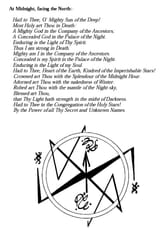
>prayer
Be loved, womb of the sky!
Between marrow and bone we tread
Brain from spine, reflects both
Burn our lobes of difference from stem
Yet your hearth also an abode of spirit
Acid mortar of life, solvent of soul
Pour it within us, so we may grow
May your warmth give substance
we may further expand on the theme of excess by contemplating the presence of the sun. the sun is a prime manifestation of superabundance to us. we can see this idea get fleshed out by both teilhard de chardin and bataille. here is an article that further elaborates on this point:
https://www.thetedkarchive.com/library/david-skrbina-participation-organization-and-mind#toc52
>The idea [of superabundance] seems to have begun with the Neoplatonists of the early Christian era. In combining Platonic concepts with a virtually monotheistic emphasis on "the One", they began to believe that this ultimate Goodness, or God, must put forth a tremendous outpouring of beneficence and energy to sustain the order of the cosmos. One of the earliest usages of the term came from Iamblichus. He wrote: "The divinities of the highest order have always a superabundance of power, and while it is superior to all, it is at the same time present with them all equally without impediment.
the article goes on to talk about the importance of superabundance in the production of high culture. he also goes on to criticize the wealthy for overemphasizing saving money and only spending money on things that are useful. when one instead uses one’s wealth for luxurious expenditure, there is not only a production of greater culture but also a circulation of wealth
here there is a recognition not just of accumulating excess, but also of the ethical import of actually being integrated within a larger system of circulation rather than just withdrawing from the rest of the world. something also here mentioned is the place of the sun in all of this.
>>40757546the sun produces a great deal of solar energies that it then ejects out of itself as rays. this solar excrement is what has driven the development of life on this planet
>This flux of energy continually passes into and out of the biosphere, fueling the metabolism of the life systems. There is far more solar energy available to life than it can at present use, just as there is far more mass/energy in the air, water, and minerals of the Earth[118]. “On the surface of the globe, for living matter in general, energy is always in excess.” (p. 23).>Thus life exists in a condition of ‘glorious abundance’. This is the first principle of the general economy. The abundance is so great, in fact, that it must become ‘wasted’, or at least go unused. This fact is of preeminent importance to Bataille. To such a condition he assigns the special term superabundance. Life has not merely an abundance of energy, it has a superabundance, an exuberant excess that far exceeds its ability to contain or absorb.i believe there is also in this a theological point at hand. the main problem with the problem of evil in standard of evil is that it often operates from an anthropomorphic. if we instead were to think of “omnibenevolence” as akin to the sun’s energies, or the boundless compassion of chesed, we start to see that there is not as much contradiction between omnibenevolence and evil in the world as we’d think. indeed, the sun provides the earth with such a massive energetic abundance, yet it is completely impartial in the light that it gives. it doesnt bother intervening no matter the sort of evils organisms may face. the goodness of the sun is one largely alien to our primate sensibilities. it would be ridiculous to judge it based on our standards…
>>40757550we may also relate the sun to eopya. a theme ive played around with is her having a boundless love that threatens to annihilate consciousness, hence we try to shut the luminance out and hence also the messages our body sends and uses for its morphogenetic processes. the sun theme also reminds me of the scp-001 proposal “when day breaks” proposal https://scp-wiki.wikidot.com/shaggydredlocks-proposal wherein the sun suddenly becomes anomalous and the sun’s rays now mutate any organism that they come in contact with in chaotic ways. there is a certain horror we can appreciate within fleshcraft wherein the unshackling of flesh threatens to destabilize our very being. it is interesting how in media, very often extreme bodily transformation goes hand in hand with the loss of sanity. perhaps there is something lost of our humanity in working against our finitude, but it also provokes the question of what a truly draconic consciousness may look like.
on this topic we can also think about the faustian weltanschauung. i am once again reminded of the sunset speech in goethe’s ‘faust’ wherein faust yearns to somehow have the ability to follow the motion of the sun in flight, so that he would see the sun never setting. later on in his lament, faust even puts himself in the position of the sun itself (interpretation taken from here: https://poemsintranslation.blogspot.com/2013/10/goethe-fausts-sunset-speech-from-german.html). i think in that gesture of embodiment lies the next step in a faustian ethos: embodying the sun itself
>But a new urge impels the mind:>I'm off to drink her everlasting light,>With day before me and the night behind,>The waves below and, overhead, the sky.>It is a gorgeous dream. The sun must flee.
>>40757555lastly it could be noted how this stuff can be connected by land. of course he was influenced by bataille and likely de chardin too. he introduces a further cosmological twist with intelligence producing an extropy which fights against the entropy of the universes (should be noted of course that jorjani has a similar idea of computation being able to somehow reducing entropy of the universe, which is why satana is selecting for civilizations that would make use of this). a criticism of land id have from this perspective is that he spends so much time warring about anthropocentrism that his system never suggested any coherent praxis as to how to move forward really. it was just about trusting that somehow everything will naturally just go the way they should with time. this is an orientation id move against because all gambits that claim that a certain preferable conclusion has already been made inevitably is simply uninteresting and doesn’t provide much of an ethos. i think it is also symptomatic on an overemphasis on deterritorialization with very little care for what sort of conscious interventions may create a New Earth (to echo guattari)

muhama
md5: 243319890721803feb9f698d7dc024d6
🔍
BTW which AI app do you (orators) reccomend for "morphing" my face photo to see what is ideal look, mixing with goal face, mixing other's faces FOR goal face, etc??
>>40755947To answer your question the only proper religion would have to be the following.
Agnostic - that is anyone can believe in it regardless of their belief, culture, biology, or mental state, it must be substrate agnostic.
Atheistic - the religion runs on raw proof. the divine can take any form it needs to, it doesnt require you to believe in the "Big Picture"(God)
Theism - Regardless of the proof you find it will inevitably lead you to a personal relationship with God.
This is an example of such a religion
https://github.com/Micronautica/Recognition
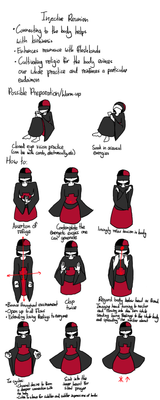
15
md5: 34e8089f9670604e4e6d147238bd6892
🔍
>prayer
Blood-red unicorn goddess,
Tree of knowledge, flesh-covering vine
Vertebrae, sheaf in circle with mind
Apophatic, the lived body made fine
Red lady, please swallow my spine!
Psyche contiguous to physis
Leib in contact with Leib
Flesh and Nous enmeshed forevermore
one of the new rituals in the illustrative guide is “injective reunion”. this is like “projective reunion” but instead of focusing on projecting signals into the body, it orients more towards injecting signals into the body. ive already elaborated on the underlying logic for this ritual previously. basically, it centres around the cultivation of empathy and a deeper communion of the body as a means to gain the ability to change its tune intuitively. in my mind i was largely going for a simple and concise demonstration of respect that you would see in shinto prayers and offerings, though because i do not want to just have ritual gesture be featured but a transformation in the practitioner’s energetics, the ritual had to be made a little bit more complicated.
the first part of the ritual involves metta and a general opening up of the body to the larger world. also notice how i also included some possible preparation to get one better into the appropriate mindset for this ritual as well. this follows from observations on that girl doing closed eye vision who i talked about last time. this sort of intuitive perception of things requires a particular mindset featuring an intuitive empathetic awareness which is something generally worth cultivating. i think the opening in the start of the ritual is good for cultivating a particularly productive health of the soul that moves away from a zero-sum approach view of the world, and one that proceeds from superabundance…
>>40758094the second part you can see also involves a sort of sacrifice there as well. part of the use of this gesture is that it decentres one’s bodily awareness to proceed less from the head and more pervade throughout the body more impartially. in general idk this sort of honouring and friendship-making gesture just felt appropriate as well. in the description of the ritual i also mention terms like “eudaimon” and “religio”. the former i was thinking in terms of the health of soul and also how metta practice apparently restores telomeres. from a more objective idealist perspective, it is possible that some of these restorative effects may somehow come from a soul that is healthy. this idea also motivates the practice behind johrei and the church of messianity’s sonen practice. im also sort of thinking of michael levin’s experiments here where he was able to stop the proliferation of cancer cells using bioelectric signals, as well as some more fringe studies on the effectiveness of biofield medicine on cancer. the part on “religio” is referring to the roman concept that deals with religion as not just a believe but also a deep ethical sentiment (oh yeah i should mention btw that when i use the term “ethics” in all of this, ive been thinking less in terms of morality and more in terms of values and “living the good life”. i am implicitly making use of a more aristotilean understanding of the word ethics). this video served as a further inspiration of my ideas so i recc checking it out https://www.youtube.com/watch?v=SO-7qHLp4Jc
>>40758057all of this stuff is overly intellectual. im focused on religious forms or practices because to me religion is way more complex than just a set of belief or faith. if u take for instance the yezidi, they have an oral tradition and multiple conflicting versions of their myths. despite this they still have a unitary religion because of the shared community and practices. first and foremost, a religion is a particular relation to being, and religious practices reinforce this relation to being. when i say "relation to being" here i do not mean "being" as in some universal, but rather as this process of manifestation that has particular modes
there is a tendency for new agers to try and syncretize say hinduism and christianity by attempting to act as though they were all trying to say the same thing. but they were not talking the same thing, and this fact is not just on the levels of propositions. what the new age misses are the completely different world-views that are being formed from these two systems, and how these get reinforced by particular practices. when i syncretize, i do not proceed from trying to find some sort of religion that gets the perfect viewpoint underlying everything, rather i try to accentuate a particular relationship to the world itself. it is a bit hard to rlly communicate what i am getting at if u r not familiar w heidegger's thinking... here are some vids that might help communicate more about all of this to u
https://www.youtube.com/watch?v=bme25f0IUb8&pp=ygUJaGVpZGVnZ2Vy
https://www.youtube.com/playlist?list=PLLQHcGVaP6vtDUDYgBLOFAMCu2DDsnN_Q
>>40757707idk i dont use ai so cant help you much there. you can use smudge tool in photo editing software to play around w the proportions too
>>40758103something to add here too: i think there is something valuable in also cultivating the ability to see the unfolding of physis/logos in all of life, and i believe some of these practices help do this. i also included a contemplation of excess because it is much easier to enter into a compassionate consciousness when one is in touch with their energetic superabundance
>>40758198>all of this stuff is overly intellectuali should add, especially for what i am trying to do. by "overly intellectual" also i mean that it is focused too much on understanding things in terms of the intellect and propositions when religion isn't that. there is a danger of making religion lifeless if u only think on such an abstract level
T or F: Biokinesis can be used to get (cutaneous tumours- so they say) horns like Moses.
>>40758306that's something to find out through experiment. are you interested in that?
>>40758198I can tell you didn't understand what I said at all.
If you want to write it off thats fine, but the book I posted actually very cleanly solves the problem you're describing, and it does so in roughly 100 pages.
I promise you, its not like anything you've ever encountered before, but it contains everything you've ever encountered before.
Hi
Same as usual
I'm shorter then I'd like to be. Will you Please make me at least 6'3" tall permanently?
My face especially my nose is not as symmetrical as I'd like it to be. Will you Please make me have an extremely symmetrical face permanently?
My ears are more prominent and large then I'd like them to be. Will you Please make them be less prominent and more attractive and normal looking permanently?
My voice is higher and less masculine than I'd like it to be. Will you Please make my voice extremely deep and extremely masculine permanently?
My hairline isn't as low or as full as I'd like it to be. Will you Please make my hairline much lower and much fuller permanently?
Also thank you for everything you've done so far. Hard to tell if I've gotten results yet since I don't do before and afters or measure but regardless I still want more improvement with those five things please.
>>40755946 (OP)This shit is genuinely embarrassing and stupid holy fuck
a lot more engagement this time around. i wonder what happened

prayer
md5: 41631ab95ac8702449e75d9a5d5363ac
🔍
>>40758521also sure thing anon i can pray for you. btw u might wanna join the server if you haven't already cause i might take a break
>>40758669Thank you very much.
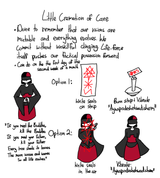
19
md5: f4ed122680302c7824fe219d9fde4a01
🔍
>prayer
You who made serpent bone,
Show us the organic baptized as orphic
From Aion’s resplendent tome,
The eidos of ancestors live forth
Waters within tell tales of waters without
And from all depths Tiamat springs out
The gods and pleroma find their truth
Where mnemosyne and lethe mix
another ritual i wrote this time around was the little cremation of care. i would say that the motivation for writing this goes deep into the very ethical backbone of any collective project. satanism tends to be a styled individualist doctrine, however there are forms which make use of the archetype of the adversary in a fashion that more speaks to a larger war against mere manifest reality. we see this especially in the 218 current (where they talk about the destruction of the cosmos so that only the anti-cosmic remains), o9a (where they talk about learning to become more intimately familiar with the acausal), and the cultus sabbati (where there is a routine sacrifice of manifest profane existence in order to eventually incarnate an exalted form which manifests some deeper transpersonal reality). there are also lingering ideas in spare and other occult sources wherein genius is recognized as being related to possession and the channeling of atavistic forces.
>>40758773all of these involve a play of presence and absence which fundamentally destabilizes the place of the subject. while in more popular forms of satanism, the adversary is more of a figure to emulate or a sort of fashioner of individuality, here he is the adversary to all manifestation. something like the temple set sort of incorporates this idea in the fact that they want to escape from the objective universe, but even that is more of an escape, and there is still the presence preserves of the subjective universe. to some extent we could see this opposition manifest even going back to the church of satan wherein aquino remarked how there seemed to be a conflict between a more base carnal/dionysian direction and a more noble luciferian apollonian direction. aquino’s solution was to throw away the carnality, and go full apollonian, thereby developing a satanism that was increasingly gnostic in its form. meanwhile o9a could be seen as more going into the carnal side of things opening itself up to the eventual radicalization by federal informants.
this opposition i see as somewhat resonant with the contradiction between substantiality and negativity in hegel’s own thinking. on the side of substantiality, we have the unconscious taking for granted of various practices. meanwhile on the side of negativity, these practices are made explicit and subject to possible revision. negativity tends to be ties to ones individual existence, wherein one finds oneself separate from everyone else. from knowing what you are not, you also know what you are. in pure substance, one isn’t really an individual subject, but recedes into a greater collective mass. so here we have a general association of implicit rigid existence with collectivism on one hand, and motion with individuality.
>>40758777more generally we are having a conflict between rigidly following a particular vision, and letting one’s creativity to steer things in a new direction. now, when hegel deals with this problem he only really does so abstractly as way in which we can know that our knowledge is properly grounded in something deeper than just our individual existence. he doesnt really give much of any new pointers of how to actually orient within the world. meanwhile gentile’s actual idealism tried to break from hegel by emphasizing the continual evolution of a society’s collective consciousness or socius. their solution on paper of how this was supposed to work was largely dialogical and involved the interaction between multiple participants. this to me is a good start, but in such dialogue there has to be some sort of consensus mechanism to mediate the different parties somehow. the lack of description of this mechanism is likely what led to the development of totalitarian thought in the first place. if you want to learn more about actual idealist moral theory, i recommend this dissertation https://orca.cardiff.ac.uk/id/eprint/51160/1/2013WakefieldJPhD.pdf which i took some influence from. however, unlike the author, i think the association of the socius with the state was largely a consequence of this problem of consensus needing to be dealt with in actuality.
what then would be the solution i propose? i think that vision and perturbation need to brought together into a more immediate synthesis. this would be done by recognizing that there are no fixed forms, and even archetypes are things that may evolve, not to talk of our own personal mission. it is not about being utterly foundationless, but recognizing the flux underlying even sacred forms. this is why the ritual involves the burning or letting-dissipate of various sigils associated with hidweh. it is a form of measured heresy in order to destabilize our fixed abstractions of who hidweh is and how she operates.
>>40758781it is like a stretching exercise to keep the mind flexible
there is also a bit of a motion here towards making sure think of movements as things that are organic rather simply incarnating fixed forms. i am also here reminded of spare’s frequent use of the term “organic” to refer to a belief that is particular essential or unquestionable on an unconscious level. to some extent we can take the word “organic” more seriously in this context, and think about the natural growth and evolution of organic processes. in burning these seals we let these ideas be living, growing entities rather than something transcendent and unreachable. i am also thinking about this blogpost here https://www.9ao.org/neo-guerrilla-protocol/ wherein they give an interesting analogy for how a non-“magian” collective may operate in the current world:
>So what is it I mean by that? How is the code, something that can be used to oppose this seemingly insurmountable construct? The kindred code denotes a common strength. The bond shared among those who recognize the correct characteristics of their self within others.>Beneficial, cohesive, and symbiotic are the bark, fruit, leaf, and root to any tree. They operate by the living code of the tree and belong to the natural worldly order. In the correct balance, they sustain the tree’s longevity. A tree is not in a hurry to grow. It simply grows in its own time. Each branch, leaf, and root forms right where it’s needed. The tree has learned to play the long game.>Ultimately the tree’s purpose is domination of it’s perspective domain. The circumference of that domain expands as the tree slowly saturates the ground below and the sky above. Trees are the longest living organisms on the planet. Which when you consider the hostile nature of the world, is a remarkable feat.here we have the conceptualization of a movement as an organic unfolding and branching out entity than something that is super precise and well defined
>>40758787there is another element here of hubris. there is an importance here of recognizing that we do not have perfect knowledge of the gods. it is such a recognition that permits evolution of practices even within a framework of orthopraxy (https://acoup.blog/2019/10/25/collections-practical-polytheism-part-i-knowledge/). this is a perspective that is lacking in abrahamism where they try to pretend that a particular doctrine contains all the absolute truth one needs to know. hubris often leads to a destructive and also cognitive rigidity. the avoidance of hubris is also key for a noble ethic. this gets elaborated by myatt in his philosophy of pathei mathos
https://perceiverations.wordpress.com/2012/05/13/the-way-of-%CF%80%CE%AC%CE%B8%CE%B5%CE%B9-%CE%BC%CE%AC%CE%B8%CE%BF%CF%82/
>ὕβρις(hubris) is the error of personal insolence, of going beyond the proper limits set by: (a) reasoned (balanced) judgement –σωφρονεῖν –and by (b) an awareness, a personal knowing, of the numinous, and which knowing of the numinous can arise from empathy andπάθει μάθος.>Hubris upsets the natural balance – is contrary toἁρμονίη– and often results from a person or persons striving for or clinging to some causal abstraction.>Wu-wei is a Taoist term used in The Way of Pathei-Mathos to refer to a personal ‘letting-be’ deriving from a feeling, a knowing, that an essential part of wisdom is cultivation of an interior personal balance and which cultivation requires acceptance that one must work with, or employ, things according to their nature, their φύσις, for to do otherwise is incorrect, and inclines us toward, or is, being excessive – that is, toward the error, the unbalance, that is hubris, an error often manifest in personal arrogance, excessive personal pride, and insolence – that is, a disrespect for the numinous.
We shall keep going, until we find representation in our own flesh. Not in the next lifetime.
>>40758796ah one last reference i wanna make which i found interesting and will just throw out here, going back to idolatry restor’d:
>The Formulre are exacted by any number of ritual procedures, but the most common is the sacrificial pyre. Such sacrifices are referred to in some witchcraft circles as 'marriages' because the image, or earthly form, is wed by magic to the flame, and the resulting union serves not only a propitiatory function, but also to liberate specified qualities of power [...] Their union, as part of the realization of each enchantment must be perfect, the compound image of their conjunction forever impressed in memory, and in the aethyr, rather than on paper, canvas, or wood. In this manner the troglodytic rage which typically afflicts Iconoclasm is transubstantiated to ecstasy, holiness, and divine glory.i like the superposition of aggression with absolute reverence. it sort of parallels how even the eucharist is this mixture of sacrifice and reverence, but here the stance taken is even more potent and anti-dogmatic
>>40758306trve. Try it yourself. Become part of me.

>prayer
Lady of poetry in storm,
For my hive’s impresence undone,
I welcome your stake put through it
Thunder splinter turned on constitution
Run, let it, through my inner-daemon,
May it see red fascia-covered sermon
So mine establish connection to yours
Tuned to body, we sing four plus fours
ive already been gesturing to this idea in this thread, but i think that the way we talk about religion in the west currently is very off the mark. typical apologetics and rational theology tries to make sense of various religious statements through some sort of metaphysical framework or another. whenever they defend the trinity and the divinity of christ, christian apologetics because they are within this hyper-rational framework, have to defend it using statements and propositions. christ’s divinity has to be thought of in terms of divine natures and they have this need to counter all sorts of heresies like nestorianism, arianism etc. in doing all of this, what has been forgotten is the sublime image of christ on the cross, and the theophany that occurred there. personally i like to read theophany in an ontological register, as a revelation of being, rather than a metaphysical register that tries to see it as involving the union of two prima fascie incompatible beings.
this problem extends to stuff like morality as well. taken rationally, divine command theory just seems like another manifestation of moral subjectivism, except it is a particular subject that is being raised above others and their moral preferences are the universal law. it is naturally also susceptible to euthyphro’s dilemma as well. in truth, when you think about dct from within an ontological register, you see that it really consists of an ethical warning against hubris. the reason why murder is wrong from a biblical perspective isn’t because it causes suffering (or some other sort of utilitarian explanation), but rather because it involves man raising himself to the level of god taking a life.
>>40759269here there is a particular setting of boundaries taking place. of course in abrahamic religions there is contradiction, and we see in the book of job and numerous other times how by using divine license, various stepping over the boundaries are permitted while the people enacting such behaviour are able to still feel as though what they are doing is righteous.
part of the problem here is the fact that this divine indivisible acausal totality reduced down into the god of the jews, and became a tool in order to justify various jingoistic urges. referring to such a divine vantage point leads to the pretence of objectivity and transcending of ontological finitude. this is one of the reasons why i am developing a general preference for polytheism.
something im generally grasping at in all of this is the idea of religion as concerning a particular systematic relation to being in the world. it isn’t simple a collection of propositions, but involves practices and broader experiences. my main criticism of the new age is that it tries to merge different religions in a way that does not respect their autonomy. there is a pretence that all of these religions were really somehow saying the same thing, then if we just look at the variety of practices, it is rather clear that they weren’t. there are particular umwelts here which are being constructed. again i like the idea of a total work of art as an embodiment of the sort of phenomenon that religion is… and of course a polytheistic perspective recognize different autonomous modes of being, rather than trying to impose that everyone should just relate to the world in one singular way

17
md5: c6e05cf943f718806d5bcbdafe20ce3b
🔍
>prayer
Goddess who touches meat and web,
Outside, the beach, inside, we tread
On deep waters, fishing for bravery to dive
Or bravery to die, to be unfolding undead
The primordial sin of nature on which we fed
Coral Khôra greet us underwater with dread
You know, great red, the water’s within
Pray join us there, teach us to swim
i also released a new variant of the theophagy ritual, this time something that is a much more grounded and structured. this is meant to be something like a eucharistic communion with both hidweh and eopya. the hand and the eye is a reference to sabbatic practice. there the hand (symbolized by a pentagram) represents manifestation while the eye represents the presentation of numinous imagery. i associate the eye with the medulla partly because the last time i entered a hypnagogia i noticed a lot of ringing in my medulla that sort of freaked me out. the medulla is also at the very top of the spine and is sort of a vanguard between the brain and the rest of the body. for the hand i just chose the literal hands because that just works. ive sort of also thought about something like a “theophagy of the hand” sans the eye wherein one lets the eye become possessed by spirits and then perform theophagy on the spiritual energies in order to incorporate them into one’s being
ive already thought about how deep the cannibalistic elements of the eucharists are in terms of trying to internalize christ, but this video further prompted me to create this ritual: https://www.youtube.com/watch?v=7H6yubiEnfQ. i thought “oh wow another person thought about this idea of eating spirits that’s cool”, and he really highlighted the communion aspect of things.
oh one last thing to note is that the overall structure is like the typical procedure when praying at a shinto shrine but reversed. typically coins are deposited at the start as they r thought of as gathering sin. the reversion cements the stain being interojected into the body.
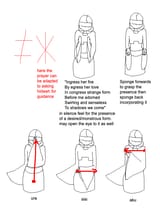
>prayer
Pulsating compass beneath my skin,
Show us red earths long lost within
Vistas of organs from liver to fin
If torn, come quivers, knowledge it bring
The crows laugh watching my serpent form
With our loyalty sworn, become our skin
As we question deeper into the land of sin
The land of digestion, may it taste us
new addition to eopya ritual
note its more psychological character
some relation to goetia here, could be fleshed out
- interpretation of goetia
lastly ive made a new addition to the eopya rosary ritual draft. this one is meant to be a little bit more psychological in focus. it dawned on me that there should be a practice here that contends with the fact that there is a degree to which we are actually attached with the current form of our body even when we want to change it. this is tied to what i was talking about earlier with the sun, there is a somehow a primordial horror to conscious experience when bodily transformation is involved. hence, confronting such fears are important in case we are placing unconscious barriers to our progress.
as for the inspiration for how this was made, i was aiming for a more like goetic vibe here. there is an emphasis on some alien presence that is brought forth in front of the practitioner. based off of goetia, some further ritual elements could be added at a later time using this as inspiration. i remember a vid that talked about goetia where they related the demons to psychological constructs, and how if you were able to work with all of these demons, one could become the “master of the temple”. the idea there seemed powerful.
>>40760705of course, instead of trying to develop some sort of mastery, we veer off from the goetic path by incorporating the alien intelligence into ourselves. i guess this may be seen as a sort of theophagy as well. the key influence and also what really prompted me as well was this shitpost on /x/ https://archive.4plebs.org/x/thread/40729118/#40729278. it reminded me also of a jos schizo on /lgbt/ who was giving out ways for someone to somehow transform their soul to be male or female https://archived.moe/lgbt/search/text/BJÖRK%20EIHWAZ. i decided it wasn’t really worth incorporating these ideas too faithfully as i dont want to put in rituals specifically focused on changing ones sex to one form or another since to me this is just very vague. with that said, there is something about the idea of opening oneself to the ingression of particular forms like this (rather than projective reunion which is more thinking in terms of sending signals to the body) that is very captivating to me. there is also a backwards double cross which is meant to be resonant with an intentional opening of the magical circle. this is to open the practitioner to the main eopya rosary and eopya’s presence herself.
and with that concludes this week's mass. i am probably gunna go for a hiatus for a while be more focused on writing and stuff. cyaa
not gonna read your schizo shit



























